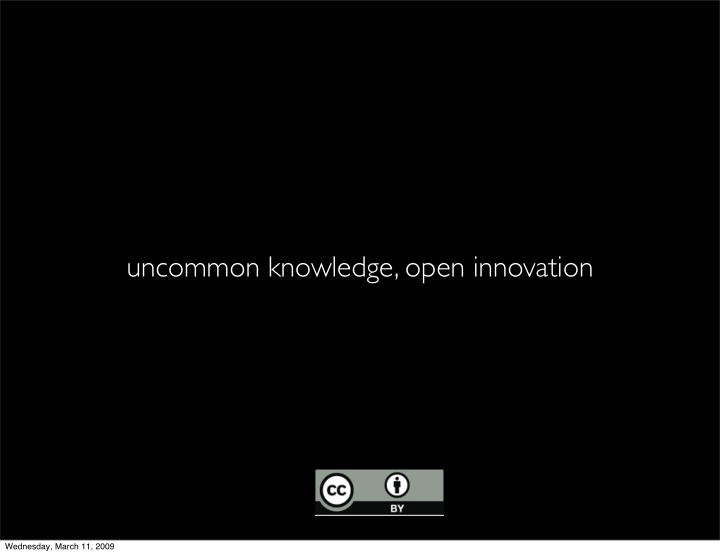



uncommon knowledge, open innovation Wednesday, March 11, 2009
how do we make the web work for science? Wednesday, March 11, 2009
we need more from what we know. Wednesday, March 11, 2009
we need more from what we know. Wednesday, March 11, 2009
“compatibly communicating” devices . Wednesday, March 11, 2009
“compatibly communicating” knowledge? Wednesday, March 11, 2009
1. science on the net: digitized, not digital. Wednesday, March 11, 2009
Wednesday, March 11, 2009
Wednesday, March 11, 2009
Wednesday, March 11, 2009
Wednesday, March 11, 2009
Wednesday, March 11, 2009
stable systems have “immune” responses to change. Wednesday, March 11, 2009
Wednesday, March 11, 2009
Wednesday, March 11, 2009
Wednesday, March 11, 2009
there is no crowd. Wednesday, March 11, 2009
the knowledge is uncommon. Wednesday, March 11, 2009
2. the digital commons - another network layer. Wednesday, March 11, 2009
computers tcp/ip documents html/http knowledge commons Wednesday, March 11, 2009
Wednesday, March 11, 2009
socially constructed rights Wednesday, March 11, 2009
“rivalrous goods” Wednesday, March 11, 2009
socially constructed exceptions Wednesday, March 11, 2009
the tragedy “rivalrous goods” is the anti-commons Wednesday, March 11, 2009
open rights. multiplicity of incentives. distributed workloads. Wednesday, March 11, 2009
Wednesday, March 11, 2009
commons as infrastructure Wednesday, March 11, 2009
computers tcp/ip documents html/http knowledge semantics Wednesday, March 11, 2009
“papers” IGFBP-5 plays a role in the regulation of cellular senescence via a p53-dependent pathway and in aging-associated vascular diseases Wednesday, March 11, 2009
“networked knowledge” IGFBP-5 plays a role in the regulation of cellular senescence via a p53-dependent pathway and in aging-associated vascular diseases Wednesday, March 11, 2009
making computers understand things Wednesday, March 11, 2009
making computers understand links between documents links to Web page Web page Wednesday, March 11, 2009
making computers understand relationships between ideas causes drinking coffee feel awake Wednesday, March 11, 2009
URLs for concepts, not just pages “coffee” coffee “cafe” http://ontology.foo.org/1234567 “kopi” Wednesday, March 11, 2009
www Wednesday, March 11, 2009
3. hard to do, but not impossible. Wednesday, March 11, 2009
digital content research tools technology Wednesday, March 11, 2009
research tools Wednesday, March 11, 2009
coming soon. Wednesday, March 11, 2009
Wednesday, March 11, 2009
digital content Wednesday, March 11, 2009
>1000 journals under CC image from the public library of science licensed to the public under CC-BY 3.0 Wednesday, March 11, 2009
what do these ideas mean in a world of integrated data? Wednesday, March 11, 2009
interoperate with the public domain. Wednesday, March 11, 2009
announcing: personal genomes under CC � , available via filesharing networks Wednesday, March 11, 2009
Wednesday, March 11, 2009
Wednesday, March 11, 2009
Wednesday, March 11, 2009
Wednesday, March 11, 2009
technology Wednesday, March 11, 2009
exponential content growth Wednesday, March 11, 2009
our brain capacity 1.00 0.75 0.50 0.25 0 1990 1994 1998 2002 Wednesday, March 11, 2009
990+ databases http://nar.oxfordjournals.org/cgi/content/full/gkm1037/DC1/1 Wednesday, March 11, 2009
“find me signal transduction genes in pyramidal neurons” Wednesday, March 11, 2009
“read 189,000 pages” is not the ideal answer. Wednesday, March 11, 2009
Wednesday, March 11, 2009
Wednesday, March 11, 2009
you need four data sources to answer the question. Mesh: Pyramidal Neurons prefix go: <http://purl.org/obo/owl/GO#> prefix rdfs: <http://www.w3.org/2000/01/rdf-schema#> prefix owl: <http://www.w3.org/2002/07/owl#> prefix mesh: <http://purl.org/commons/record/mesh/> prefix sc: <http://purl.org/science/owl/sciencecommons/> prefix ro: <http://www.obofoundry.org/ro/ro.owl#> select ?genename ?processname Pubmed: Journal Articles where { graph <http://purl.org/commons/hcls/pubmesh> { ?paper ?p mesh:D017966 . ?article sc:identified_by_pmid ?paper. ?gene sc:describes_gene_or_gene_product_mentioned_by ?article. } graph <http://purl.org/commons/hcls/goa> { ?protein rdfs:subClassOf ?res. Entrez Gene: Genes ?res owl:onProperty ro:has_function. ?res owl:someValuesFrom ?res2. ?res2 owl:onProperty ro:realized_as. ?res2 owl:someValuesFrom ?process. graph <http://purl.org/commons/hcls/20070416/classrelations> {{?process <http://purl.org/obo/owl/obo#part_of> go:GO_0007166 } union GO: Signal Transduction {?process rdfs:subClassOf go:GO_0007166 }} ?protein rdfs:subClassOf ?parent. ?parent owl:equivalentClass ?res3. ?res3 owl:hasValue ?gene. } graph <http://purl.org/commons/hcls/gene> { ?gene rdfs:label ?genename } graph <http://purl.org/commons/hcls/20070416> { ?process rdfs:label ?processname} } Wednesday, March 11, 2009
precise answers to complex questions DRD1, 1812 adenylate cyclase activation ADRB2, 154 adenylate cyclase activation ADRB2, 154 arrestin mediated desensitization of G-protein coupled receptor protein signaling pathway DRD1IP, 50632 dopamine receptor signaling pathway DRD1, 1812 dopamine receptor, adenylate cyclase activating pathway DRD2, 1813 dopamine receptor, adenylate cyclase inhibiting pathway GRM7, 2917 G-protein coupled receptor protein signaling pathway GNG3, 2785 G-protein coupled receptor protein signaling pathway GNG12, 55970 G-protein coupled receptor protein signaling pathway DRD2, 1813 G-protein coupled receptor protein signaling pathway ADRB2, 154 G-protein coupled receptor protein signaling pathway CALM3, 808 G-protein coupled receptor protein signaling pathway HTR2A, 3356 G-protein coupled receptor protein signaling pathway DRD1, 1812 G-protein signaling, coupled to cyclic nucleotide second messenger SSTR5, 6755 G-protein signaling, coupled to cyclic nucleotide second messenger MTNR1A, 4543 G-protein signaling, coupled to cyclic nucleotide second messenger CNR2, 1269 G-protein signaling, coupled to cyclic nucleotide second messenger HTR6, 3362 G-protein signaling, coupled to cyclic nucleotide second messenger GRIK2, 2898 glutamate signaling pathway GRIN1, 2902 glutamate signaling pathway GRIN2A, 2903 glutamate signaling pathway GRIN2B, 2904 glutamate signaling pathway ADAM10, 102 integrin-mediated signaling pathway GRM7, 2917 negative regulation of adenylate cyclase activity LRP1, 4035 negative regulation of Wnt receptor signaling pathway ADAM10, 102 Notch receptor processing ASCL1, 429 Notch signaling pathway HTR2A, 3356 serotonin receptor signaling pathway ADRB2, 154 transmembrane receptor protein tyrosine kinase activation (dimerization) PTPRG, 5793 transmembrane receptor protein tyrosine kinase signaling pathway EPHA4, 2043 transmembrane receptor protein tyrosine kinase signaling pathway NRTN, 4902 transmembrane receptor protein tyrosine kinase signaling pathway CTNND1, 1500 Wnt receptor signaling pathway ` Wednesday, March 11, 2009
Recommend
More recommend